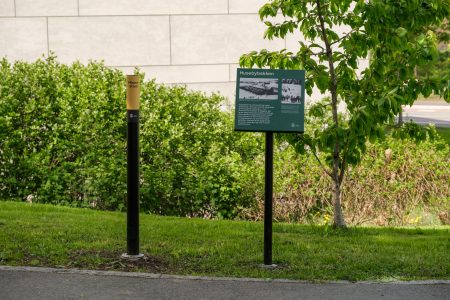Memory Lane – a universally designed outdoor meeting place

Summary
Memory Lane is an age-friendly and universally designed outdoor meeting place in the Ullern district of Oslo. Memory Lane is a result of citizen involvement and cross-sectoral cooperation. It wouldn’t have been possible to implement without those two key factors.
Memory Lane is for everyone in all generations. You can come with a wheeled bag, a pram, or in a wheelchair. The clearly marked path stretches between Ullern Health Center and the nursing home and contains benches and signs with historical information as well as an activity park. The contents of the signs reflect significant input from the seniors’ council, which has a deep sense of community and knows what may be interesting for people who live in the district. The activity park contains a petanque court, benches with pedals, chess tables, hammocks, trim stairs, and parallel bars.
At the senior center, called Ullern Cultural Centre, we have a regular meeting for older persons called MandagsStoppen. The district wants to hear about people’s thoughts. One of the older persons proposed a dementia trail, which came into being as Memory Lane. The change of name had to do with the district posting a competition in the local newspaper, asking what the readers would suggest calling the trail.
Our goal is promote activity and public health, keeping people active by having a space to meet others. Learn more by watching a video here.
https://www.youtube.com/watch?v=uCP_nFTgBSg
Key facts
Older people in general
Health
Meet their basic needs
- Ageism
- Accessibility
- Ageing in place
- Dementia
- Healthy behaviours (e.g. physical activity)
- Intergenerational activities
- Inequities
- Inclusion
- Participation
Age-friendly practice in detail (click to expand):
Engaging the wider community
Social or health care provider
- Social or health care provider
- Volunteers
The project leader is an employee from the district Ullern. Memory Lane is a result of citizen involvement and cross-sectoral cooperation. Different sectors in Oslo collaborated and it wouldn`t have been possible to implement Memory Lane without this cooperation. The project leader prioritized good communication and established an atmosphere of respect for contributors’ ideas.
Funding: The district applied for funding to complete the Memory Lane project. We applied through a fund aimed at creating accessible meeting places and the Accessibility Project. We have also contributed with own funds.
Older people were involved in the age-friendly practice at multiple or all stages
Memory Lane would nothave been realized if it wasn´t for the suggestion from an older person. The seniors’ council had a great impact on the content of the signs with information about the local history.
Moving forward
No
No
Positive feedback
Two older persons informally provided feedback, sharing that they were inspired by Memory Lane and that they would like to make something similar where they live.
Another person shared the following experience via email:
“The Memory Lane has been an important element in the convalescence for my mother. Walking area right outside the door, with benches to rest and equipment in the activity park to exercise! A great addition to the convalescence at The Center of Health”.
Yes, we would like to add some new components and make some small adjustments like moving one of the markers, adding a new sign with a poem made for Memory Lane, and add more flowers during the path.
Looking back
Determining responsibilities for repairs and maintenance would have been beneficial, ensuring that these responsibilities were clarified and written down.
The main challenge was how to communicate with the many different sectors involved. It was important to involve everybody in the process at all times, finding meeting times which were convenient for everyone, and always keeping everybody updated and listening to their points of view.


